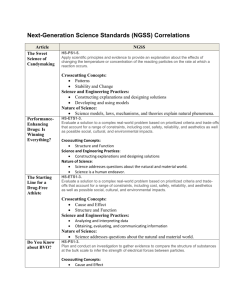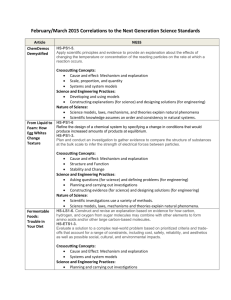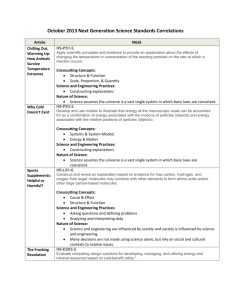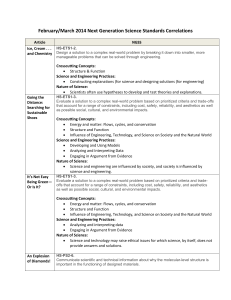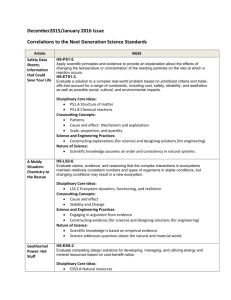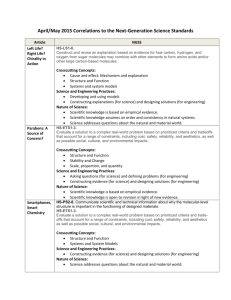(C3)– Melding Mechanisms, Models, & Minds
advertisement
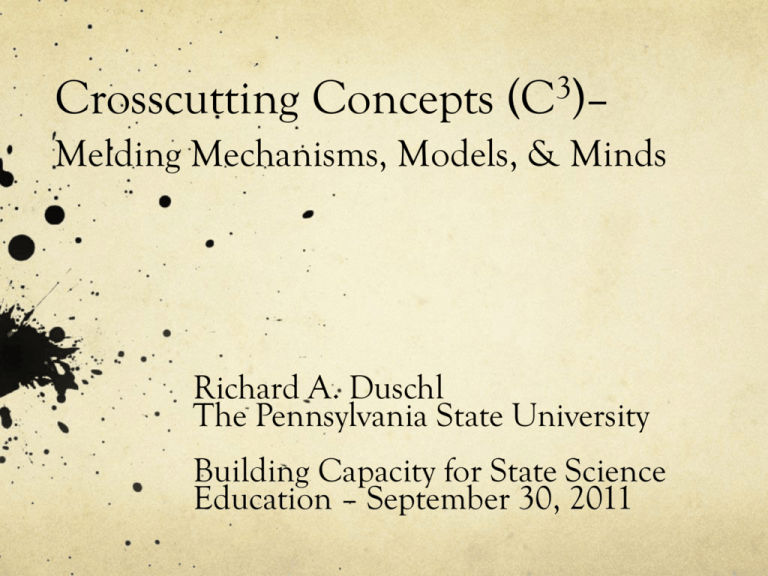
Crosscutting Concepts (C3)– Melding Mechanisms, Models, & Minds Richard A. Duschl The Pennsylvania State University Building Capacity for State Science Education – September 30, 2011 Crosscutting Concepts Core Ideas + Scientific Practices Inquiry & Nature of Science Curriculum Instruction + Assessment Aligned Instruction-Assisted Development & Learning Performances When did NOS become a focus of Science Education? James Bryant Conant (1947) On Understanding Science: An Historical Approach (Yale University Press) Science Education for Non-scientists – lawyers, writers, teachers, public servants, businessman Clarification of Popular Thinking about Methods of Science Close study of a FEW SIMPLE Case Histories Cultural Assimilation of Science . . .in the New Age of machines and experts. Some understanding of science – Pure & Applied (Is research & method different?) vs. Social Sciences (Is it really science?) Tactics & Strategies of Science as the goal of science education for non-scientists (p 12) “The stumbling way in which even the ablest of the early scientists had to fight through thickets of enormous observation, misleading generalizations, inadequate formulations and unconscious prejudice is the story which it seem to me needs telling” (p 15) Philosophical analysis has led to misunderstandings of science (Logical positivism, language & logic) “The case histories would almost all be chosen from early days in the evolution of the modern discipline.” (p 17) Physics – 17th & 18th Centuries Chemistry – 18th & 19th Centuries Geology – early 19th Centuries Biology – 18th & 19th Centuries (certain phases) From Duschl & Hamilton (2011). Science. In P. Alexander & R. Mayer, eds. Handbook on Learning and Teaching, London: Routledge. [P]hilosophy of science had been conducted in a relatively a priori fashion…with philosophers of science just thinking about what scientists ought to do, rather than about what they actually do do. This all began to change in the 1960s and 1970s, when philosophy of science took its’ so-called “historical turn.” [emphasis in original] (Carruthers et al., 2002, p. 3) It became important, then, to see science, too, as a natural phenomenon, somehow recruiting a variety of natural processes and mechanisms–both cognitive and social–to achieve its results. Philosophers of science began to look, not just to history, but also to cognitive psychology in their search for an understanding of scientific activity. (Carruthers et al., 2002, p. 4) Pickering’s Mangle of Practice “three elements: a “material procedure” which involves setting up, running and monitoring an apparatus; an “instrumental model,” which conceives how the apparatus should function; and a “phenomenal model,” which “endows experimental findings within meaning and significance . . . a conceptual understanding of whatever aspect of the phenomenal world is under investigation. The “hard work” of science comes in trying to make all these work together” (Zammito, 2004; pp. 226-227). Ford, M. (2008). “Grasp of practice” as a reasoning resource for inquiry and nature of science understanding. Science & Education, 17, 147–177. Deepening & Broadening Scientific Explanations (Thagard, 2007) Epistemic Achievements Epistemic Attempts/Failures Relativity Theory Crystalline Spheres Astronomy Quantum Theory Catastrophist (Flood) Geology Atomic Theory of Matter Phlogiston Theory of Chemistry Evolution by Natural Selection Caloric Theory of Heat Genetics/Cell Theory Vital Force Theory of Physiology Germ Theory of Disease Ether Theories of Electromagnetism and Optics Plate Tectonic Theory Theories of Spontaneous Generation Thomas Eakin “The Gross Clinic” 1875 Taking Science to School (TSTS) Ready, Set Science! (RSS) National Research Council 2007 What Is Science? Science is built up of facts as a house is of stones, but a collection of facts is no more a science than a pile of stones is a house. -Henri Poincare Science involves: Building/Refining theories and models Collecting and analyzing data from observations or experiments Constructing & Critiquing arguments Using specialized ways of talking, writing and representing phenomena Science is a social phenomena with unique norms for participation in a community of peers. NRC, 2007 Taking Science to School Teaching Science Practices 1. Science in Social Interactions A. Participation in argumentation that leads to refining knowledge claims B. Coordination of evidence to build and refine theories and models 2. The Specialized Language of Science A. Identify and ask questions B. Describe epistemic status of an idea C. Critique an idea apart from the author or proponent 3. Work with Scientific Representations and Tools A. Use diagrams, figures, visualizations and mathematical representations to convey complex ideas, patterns, trends and proposed. NRC, 2007 Taking Science to School National Research Council 1996 AAAS 1993 National Science Education Standards Content Domains Big Cs Little Cs Life Science Unifying Principles & Themes Physical Science Earth/Space Science Inquiry Science & Technology Science in Personal & Social Contexts Nature of Science NAEP 2009 The set of crosscutting 3 concepts defined here is similar to those that appear in other standards documents, in which they have been called “unifying concepts” (NSES) or “common themes” (SFAA) . Regardless of the labels or organizational schemes used Tissue Engineering Laboratory in these documents, all of Georgia Tech (Nersessian, 2008) them stress that it is important for students to come to recognize the concepts common to so many areas of science and engineering. C Science for All Americans Common Themes Systems Models – Physical, Conceptual, Mathematical Constancy & Change – Constancy - Stability and Equilibrium, Conservation, Symmetry, Patterns of Change – Trends, Cycles, Chaos Evolution – Possibilities, Rates, Interactions Scale NSES Unifying Concepts and Processes Systems, order and organization Evidence, models and explanation Change, constancy and measurement Evolution and equilibrium Form and Function NSES Cubes (C3) for Cubers(CS3) Patterns (5) Cause & Effect (5) Scale, Proportion & Quantity (2) Systems and Systems Models (1, 3, 7) Energy and Matter in Systems (4) Form & Function (6) Stability (1) Science: College Board Standards for College Success Science & (Engineering) Practices 1. Asking questions (for science) and defining problems (for engineering) (1) 2. Developing and using models (4) 3. Planning and carrying out investigations (2) 4. Analyzing and interpreting data (3) 5. Using mathematics and computational thinking (5) 6. Constructing explanations (for science) and designing solutions (for engineering) (4) 7. Engaging in argument from evidence (4) 8. Obtaining, evaluating, and communicating information (1-5) Science: College Board Standards for College Success Science & (Engineering) Practices Patterns (3, 4) Cause & Effect (2) Scale, Proportion & Quantity (4) Systems and Systems Models (5) Energy and Matter in Systems (1) Form & Function (1) Stability (4, 5) Science: College Board Standards for College Success C3 “(The) crosscutting concepts begins with two concepts that are fundamental to the nature of science: that observed patterns can be explained and that science investigates cause and-effect relationships by seeking the mechanisms that underlie them.” The next concept—scale, proportion, and quantity— concerns the sizes of things and the mathematical relationships among disparate elements. The next four concepts—systems and system models, energy and matter flows, structure and function, and stability and change—are interrelated in that the first is illuminated by the other three. Each concept also stands alone as one that occurs in virtually all areas of science and is an important consideration for engineered systems as well. C3 Source-Transmission-Receptor Theory of Observation Shapere, D. (1982). The concept of observation in science and philosophy. Philosophy of Science, 59, 485-525. Theory of Source - Theory of Transmission - Theory of Reception Neutrino Capture Experiments – Vats in Deep Earth Mines Ocean Salinity Measurements – Satellite detected Salinity Variations in Oceans to Model Climate Change Groundwater Depletion Measurements – Coupled satellites processing gravity fluctuations Problematizing Evidence/Discovery Science Measurement/Observation Data Evidence Problem/Question Explanation/Theory Pattern/Model Evidence-Explanation Continuum • It has in its heart the question: “What counts”? • It seeks to work out the details of the process of constructing scientific explanations • It refers to both the content and nature of explanations and the dialectic process of explanation construction and communication within social contexts • It considers not only cognitive, but also epistemological and social aspects of dealing with data that lead to a change in scientific understandings 4 Strands of Scientific Proficiency Know, use and interpret scientific explanations of the natural world. Generate and evaluate scientific evidence and explanations. Understand the nature and development of scientific knowledge. Participate productively in scientific practices and discourse. INTERCONNECTIONS BETWEEN CROSSCUTTING CONCEPTS AND DISCIPLINARY CORE IDEAS Crosscutting concepts should be reinforced by repeated use of them in the context of instruction in the disciplinary core ideas presented in Chapters 5-8. Crosscutting concepts can provide a connective structure that supports students’ understanding of sciences as disciplines and that facilitates their comprehension of the systems under study in particular disciplines. Crosscutting concepts should not be taught in isolation from the examples provided in the disciplinary context. Moreover, use of a common language for these concepts across disciplines will help students recognize that the same concept is relevant across different contexts. Assessments to Capture Performance, Gauge Progress Embedded - part of daily teaching/activities Formal/informal observations Ss performance relative to content and epistemic practices. Benchmark - occur periodically within module Tied to specific epistemic/reasoning practice; e.g., causal explanations; modeling; argumentation Performance - larger events, Ss presented with problem that requires both content and epistemic practices Use knowledge in generative way, use evidence to support explanations, Create Learning Performances What are Learning Performances? Learning performances define, in cognitive terms, what it means for learners to “understand” a particular idea Learning performances define how the knowledge is used in reasoning about questions and phenomena Why Learning Performances Know or understand is too vague Performances require learners to use the ideas. Use terms that describe the performance you want students to learn and be able to do. Identify, Define, Refine, Analyze and Interpret data, Explain, Build, Model, Design … New View of NOS 3 C & SPs Emphasizes the role of models and data construction in the scientific practices of theory development. Sees the scientific community, and not individual scientists, as an essential part of the scientific process. Sees the cognitive scientific processes and scientific practices as a distributed system that includes instruments, forms of representation, and agreed upon systems for communication and argument. New Technologies and Tools give rise to New Theories - Thank You! New Technologies Electro-spray Ionization Mass Spectrometer Nobel Prize for John Fenn - Yale University Evolution of Seismographs New Tools Crust of the Earth as Related to Zoology San Francisco Topo Map & Google Earth Geographic Information Systems New Theories Ontogeny Recapitulates Phylogeny
